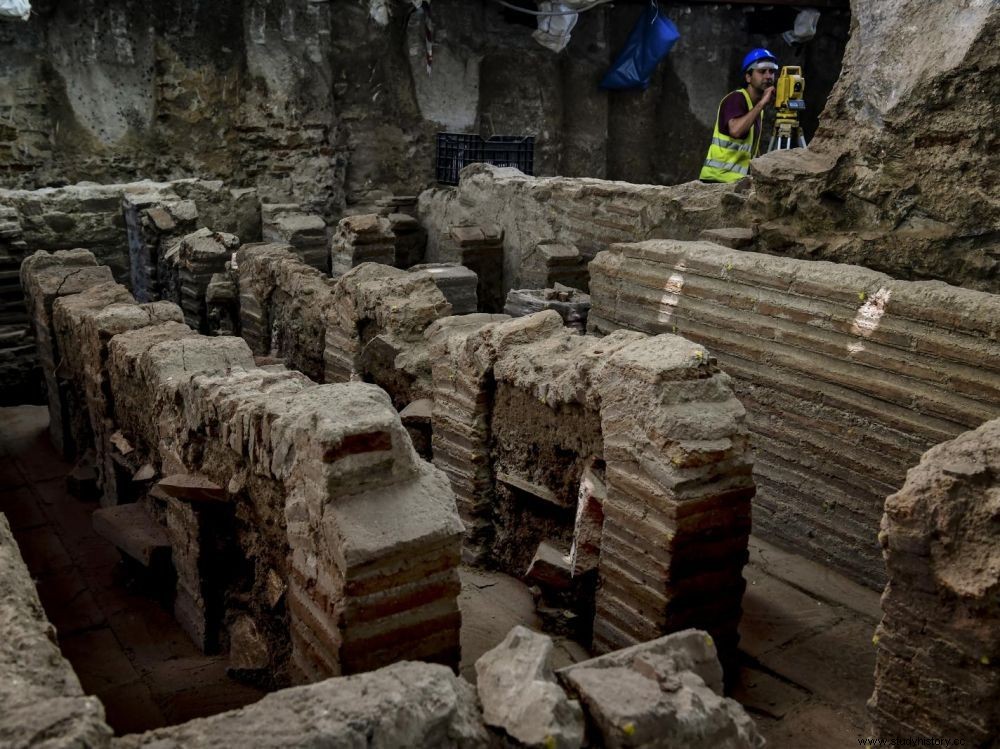The Thessaloniki Metro project, due for completion in 2020, has brought to light exceptional remains allowing archaeologists to fill in gaps in their knowledge of the city's long history.

A Greek archaeologist studies the ruins of ancient Thessaloniki discovered at the construction site of the new metro.
Armed with shovels and brooms, around twenty workers move about in the remains of an ancient villa, deeply buried under the hustle and bustle of modern Thessaloniki. Suddenly one of them leaves the group to deliver a find, a small clay head representing a bearded man with a hooked nose and a grimacing smile. "Probably a votive offering" , slices the young archaeologist on duty. This is how the Thessaloniki metro project, which should be completed in 2020 after 15 years of work, has brought to light vestiges such as a road from the 6th century and other urban planning works, allowing archaeologists to fill gaps in their knowledge of the city's long history."We did not know that such extensive urban planning had been carried out at that time, probably under (the Byzantine Emperor) Justinian" , observes Polyxène Adam-Vélèni, head of the Department of Antiquities of Thessaloniki at the Ministry of Culture. "We were surprised to discover the road in such exceptional condition, this phase of the city's history was unknown to us" , she explains to AFP.
50,000 coins discovered
Other finds like the villa are older, dating to the end of the fourth century. On the floor of the hot bath, archaeologists found a gold ring, "probably misplaced by a young woman who made the mistake of taking her jewelry to the bath" , estimates an archaeologist of the site. Founded in the 4th century BC, named after the half-sister of Alexander the Great, Thessaloniki was an important center of the Roman Empire before becoming the second city of the Byzantine Empire after Constantinople. The city continued to grow under the Ottoman Empire with the arrival in the 15th century of thousands of Sephardic Jews expelled from Spain.
The excavations thus revealed more than 300,000 important objects, including 50,000 coins, in addition to two marble squares, a 15-meter fountain and an early Christian church. Along the main paved road, the Decumanus Maximus, excavation teams also found the remains of workshops made of earthen bricks where jewelers practiced, as they still do today, in apartments above the future metro. Typical of the region's gold crowns and jewelry have also been found in more than 5,000 tombs and tombs along the subway route, but it's another seemingly more humble find that has archaeologists in awe, according to Mrs Adam-Véléni. "We found containers shaped like hand grenades, and at first we didn't know what they were used for, until we realized they were used to store mercury needed to make jewelry, a discovery very valuable" , she explains.
"The municipality was called upon to choose between the metro and antiquities, but it was a false dilemma"
Construction of the metro was ordered in 2003 and work began three years later. It was originally due to be completed in 2012. But the project has come up against debate over how best to preserve the antiquities discovered, says Yannis Mylopoulos, president of state-owned railway construction company Attiko Metro. The archaeological excavations cost more than 75 million euros according to the company."The municipality was called upon to choose between the metro and the antiquities, but it was a false dilemma... we do both, the city discovers and exposes its history" , remarks Mr. Mylopoulos, professor of civil engineering and former rector of the Aristotle University of Thessaloniki.
Once completed, the walkways above the two metro stations where the main finds were made will provide a general view of the Old Town's shopping district. "These will be sites open to the public...a city under the city, exactly as it was in the third and fourth centuries" , he rejoices. At a cost of 1.5 billion euros, the Thessaloniki metro will initially have 13 stations over a distance of 9.6 kilometres. Future expansion is planned to serve the airport.
